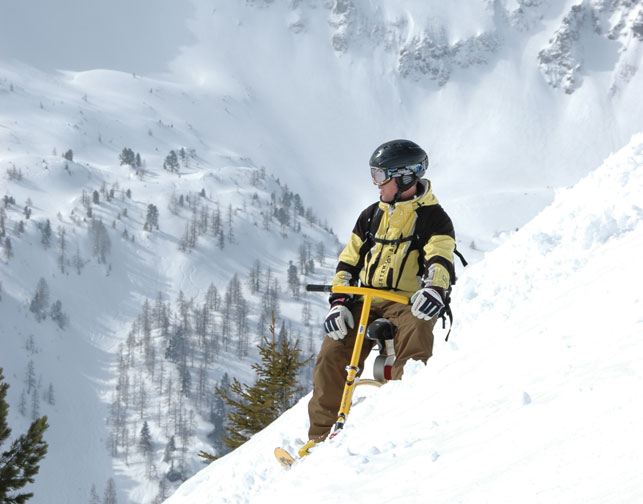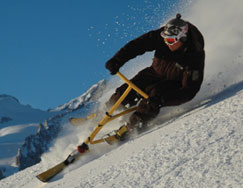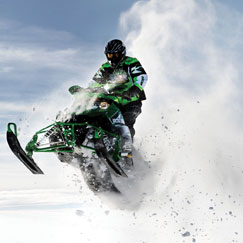Taking the piste
Methods of getting down a snow-covered mountain are typically confined to skiing, snowboarding, sledging, and unfortunate avalanche mishaps, although now more than ever you might wish to travel by bike.
Originally designed in 1949 by Engelbert Brenter, a ski manufacturer from Oberndorf, Austria, the Snowbike is a piece of equipment that performs like skis, but in a more stable position. The end product is capable of travelling at over 100mph, off piste, and over powder, piste, ice, and ‘freestyle’ moguls.

First developed from a traditional bike frame, the modern incarnation has little in common to its wheel-based inspiration. “All the components are unique. We cannot use any bicycle parts as the Snowbike has a completely different temperature range to serve and stress situation,” says Brenter Original Snowbike CEO, Bernd Brenter.
In addition, the bike must be low in weight to make for high-speed riding performance and comfort, while a complex suspension system has to take in the frame geometry and handle the response of the skis.
Every new model starts with simple hand drawings to give the overall proportions and this is followed by taking the design into 3D with models created in AutoCAD and Pro/E.

The Brenter Original Snowbike is capable of travelling at over 100mph, off piste, and over powder, piste, ice, and ‘freestyle’ moguls
The Pro/E models are tested to simulate stress and for plastic moulding. However, Brenter’s design team still relies on physical testing for the different snow conditions that are hard to simulate.
“Prototypes are built that go through many on slope and off-piste test procedures,” explains Bernd, adding that his team even sets up special test machines in its workshop. “Before we sell a product we have thousands of miles on the bike to test all possibilities of the sport.”
This is important when configuring the complex active suspension system. Unlike a typical bike, snow sports need to ‘unweight’ and release the edge of the ski to make controlled and skidded turns. The active suspension-system developed by Brenter stores the energy and gives a controlled rebound to the rider, giving them hundreds of short gravity-free moments during one run.
From an adapted bike frame to a high-tech machine with F1 grade materials, much has changed for the humble snowbike, but the thrills of plummeting down a snow-covered alpine peak certainly remain the same.
www.snowbike.com
Super sled
Travelling in the snow is tricky and often dangerous for us sensitive Brits, which is why riding something with 177hp on the white stuff sounds crazy.
The Arctic Cat Z1Turbo is the world’s fastest production snowmobile. Clocked doing 137mph on asphalt, when the vehicle is transferred onto a more uneven surface such as snow and ice, it requires some seriously clever suspension and means of traction.
Based in Thief River Falls, Minnesota, US, Arctic Cat has been producing snowmobiles for over 40 years. Its latest development involves taking a normal four-stroke engine and turbo-charging it to give it an additional 55hp and enough power for a seriously powerful ride.

With a top speed of 137mph, the Arctic Cat Z1Turbo is the world’s fastest production snowmobile
“It is a very good trail sled with excellent trail manners, but with no turbo lag so when it is time, a simple squeeze of the throttle and you have a rocketship on the snow,” says Doug Wolter, director of snowmobile product engineering.
Alias was used to help develop the surface models, taking conceptual sketches into 3D following focus group studies. The engineering design was done using Unigraphics to help develop the chassis and suspension, with NEi Nastran performing finite element analysis on parts to ensure structural stability over the rough ride on snow at high speeds.
“Many rapid prototyping parts are used throughout the design cycle,” continues Doug. “Some are used for models for such things as fit up, others for actual prototypes, and still others used as masters for proto tooling and then injection moulded from the proto tooling”
From these prototypes several pre-production models are produced to tweak out any further adjustments before the snowmobile is put into production. DEVELOP3D already has a fleet on order for next winter. There’ll be no ‘snow days’ for our office staff in 2010.
www.arctic-cat.com

There’s no business like snow business, says Stephen Holmes






